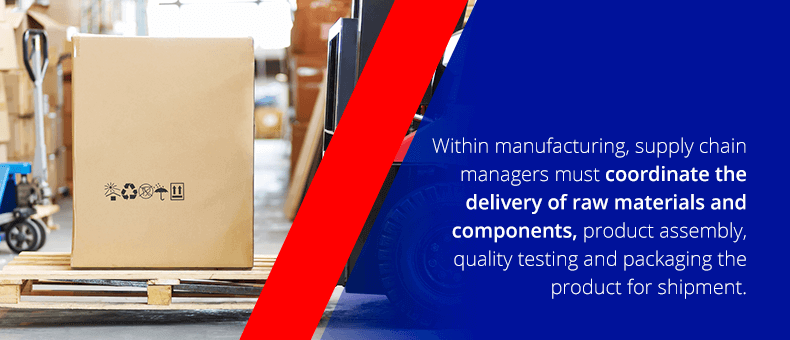Blog
What You Need to Know About Technology Supply Chain Management

Supply chain management is a challenging job, made even more complicated in the tech industry. Customers are always demanding the latest tech, and retailers rely on your company to keep their shelves stocked. Technology is known for pushing innovation and producing faster speeds with each new launch, and the supply chain is no different. Today’s supply chain professional in the technology sector needs to optimize every aspect of their supply and logistics operations to stay competitive. To further complicate matters, most tech supply chains require a wide variety for transit speeds for shipments – B2C deliveries need to meet consumer expectations and standards, repair components are often needed in hours rather than days, inventory replenishment can take longer but special attention needs to be paid to visibility and security.
Why Supply Chain Management Is Crucial
Tech leaders are under pressure to keep costs down and minimize the time to market. Efficient supply chain management is key to achieving both. Between the tech industry’s disruptors and fierce competitors, the demand for an omnichannel solution, and the complexity of manufacturing high-tech products, a mature supply network is crucial. As today’s most innovative logistics chains throughout the tech sector experience new risks and roadblocks, tech companies are placing a renewed focus on the supply chain. Resiliency and agility are critical in the modern high-tech supply chain.
Whether in the semiconductor, software or engineering sectors, an underdeveloped or poorly managed logistics chain can present many challenges for an organization. The consequences for poor supply chain management in the tech sector include:
- Low profit margins: Modern devices rely on gold, silver, lithium, silicon and other metals and minerals, which are increasing in cost. Many factors contribute to tech devices’ retail value, and consumers aren’t always willing to pay more to account for rising material costs. As a result, tech companies experience lower profit margins. They also need to worry about availability, since short supply can result in higher costs. If a company doesn’t plan for price volatility in supplier negotiations and resource planning, material costs can severely impact the bottom line.
- Manufacturing delays: Compared to other products, technology has an intricate manufacturing process. Devices require precise assembly and many interlocking parts. The tech manufacturing ecosystem results in many different suppliers delivering components such as motherboards, camera lenses and sensors, which are assembled at a final manufacturer. When any part gets delayed, the entire manufacturing process is disrupted. The time to market gets longer, and finished goods inventory can become limited, making customers and retailers unhappy. With so many vendors contributing to the final product, careful coordination, scheduling and communication are central to tech industry supply chain management.
- Eroded competitive advantage: In the tech industry, the latest innovations become outdated quickly. Your customers want the next big thing, faster speeds, helpful software updates as soon as possible. If a competitor can offer it before you, you’ll lose business. Companies are under immense pressure to limit the time-to-market, starting at the research phase and onto inception, manufacturing and upgrades. A successful supply chain management strategy will accelerate each stage and prevent bottlenecks between steps.
- Transportation delays: Most product launches are on a tight deadline, and companies can’t afford to have items stuck on a slow-moving transportation schedule, common with ocean freight. Since most tech manufacturing happens globally, with factories and markets crossing international borders, transportation can get complicated and costly. Delays can result in inventory shortages at retailers. Supply chain managers can prioritize speed by using a vast network of multimodal carriers and closely managing those relationships. They may also have to account for customs delays and need to prioritize solutions for efficient border crossings. An advanced, innovative approach to logistics is crucial.
Benefits of Supply Chain Management in the Tech Industry
While a lot can go wrong without the right approach, most tech companies stand to benefit from improving their supplier and logistics management strategy. Many companies across industries consider their supply chains a competitive advantage. Some of the areas where a lean, agile supply network can benefit your business include:
- Productivity: Supply chain management aims to be as efficient as possible. By prioritizing output and facilitating better collaboration within the supplier network, logistics managers can drive a more productive value chain. New tech can be developed and delivered faster, in higher quantities at a lower cost.
- Organizational cohesiveness: Managing a complex supply chain requires excellent communication. When an organization prioritizes supplier relationships and logistics, they can turn their supplier network into a well-oiled machine. Every department and outside vendor contributes to the success of the others, adding value along the way. Raw materials, components and final products get delivered at just the right time. Further, when supply chain leaders have a seat at the C-suite, they can drive cohesiveness and collaboration between departments. Logistics and supply chain management can better support the rest of the organization while receiving the management buy-in needed for successful management systems.
- Speed: The tech industry’s need for faster speed to market can only be met with an optimized, resilient supplier network. Supply chain management involves working closely with vendors across all development stages, optimizing production schedules and improving transportation logistics. With these priorities in place, an organization can achieve faster speeds.
The Elements of Supply Chain Management for the Tech Sector
In many ways, implementing effective supply chain management in the tech sector will look similar to many other sectors. Across all industries, companies are using a broader supplier network and more modes of transportation. Most companies consider their supply networks very complex. The tech sector has some unique considerations since the industry is often the first to adopt new strategies. Tech companies have a strong focus on innovation, as well as the need for repair management and increased security for their high-value inventory.
Here’s how to manage supply chain operations in the tech industry and the components involved in effective management:
1. Planning
Implementing a new supply chain management system requires an enterprise-wide plan. The logistics chain needs adequate resources for all the processes and roles involved in delivering products. During the planning phase, the organization should select metrics to measure supply chain productivity against company goals.
2. Sourcing
Technology industry professionals will need to consider what products and logistics services to outsource and keep in-house. The sourcing team will vet, contract, monitor and manage outside suppliers. They will also place new orders, authorize payments, receive shipments and manage inventory.
3. Manufacturing
Several tiers of manufacturers might be involved in your tech sector supply chain, depending on what you do in-house. The finished assembly manufacturer will likely contract components from other manufacturers. And they will receive raw materials from other suppliers. In technology manufacturing, everything from circuit boards, displays and batteries to antennas, microchips, microphones and cameras may come from different manufacturers.
Within manufacturing, supply chain managers must coordinate the delivery of raw materials and components, product assembly, quality testing and packaging the product for shipment.
4. Routing and Delivery
Once products are ready for their end-users or retailers, logistics managers coordinate delivering them. They manage customer orders, schedule delivery and arrange transportation, which can get as involved as deciding the exact route a shipment will take.
In the technology industry, many companies rely on air freight rather than ocean because it allows products to get delivered overseas much faster. They also rely on multimodal shipping, where products travel by air, rail and truck to their destinations. Tech companies often outsource delivery to a network of carriers, especially when certain items, such as lithium batteries, require special handling and safety precautions.
5. Returns and Repairs
Reverse logistics is a pressing concern across all industries, with U.S. consumers returning $309 billion worth of merchandise in 2019. In the tech industry, reverse logistics are more complicated because of the high value of the devices sold.
They almost always come with a warranty that offers free repairs for various covered issues. Even after the initial warranty period, it’s often advantageous for consumers to repair their tech devices for a service fee. When a customer chooses to replace a device, they frequently trade in a used product for a discount on the next.
As a result, the tech industry has an exceptionally well-developed returns, repairs and after-market logistics operation. Tech companies must account for returns and repairs for faulty products as well as the regular dose of buyers’ remorse returns. For trade-ins or used products returned under warranty, they must consider refurbishment or safe, legal disposal methods.
6. Security
The need for security in the technology industry is obvious. In sectors that sell and transport high-value items, like mobile phones and computers, supply chain managers need to take extra precautions against theft. Warehouse theft and cargo theft alike pose the threat of inventory shrinkage. Tech manufacturers also have to combat counterfeit products and fraud in the returns process.
Serial numbers are one element of this security because they allow companies to record the rightful owner of a product sold in the market. Serial number tracking makes it harder for thieves to resell stolen devices or to have them repaired. It can even allow companies to track stolen devices and render them useless if they end up in the wrong hands.
Cargo and retail items will also come implanted with security devices to prevent thieves from accessing packaged products until they are purchased. Tech inventory usually includes radio frequency identification (RFID) devices that allow companies to track items while in the warehouse or in transit. Logistics managers can track their cargo and merchandise and intervene early following a theft.
What to Consider Before Implementing a Supply Chain Management System
Before you optimize or overhaul your supplier network management system, you should consider your company’s needs, especially those unique to the tech industry. There are several things to know about technology supply chain management, including:
1. Complexity
In the tech industry, supply chain management is increasingly complex. The tech sector is asset-driven, and most companies need to maintain a large volume of high-value inventory. They may rely on an extensive network of suppliers to design and manufacture delicate, high-tech components. They must also track parts and finished products by serial numbers.
Tech companies are keeping more items and launching new products at a faster rate than ever before. They need to develop new software and update existing software. Meanwhile, they need to manage worldwide sourcing and deliveries and follow international regulations.
2. Your Operations Strategy
There are many ways to organize a supply chain and the flow of goods, cash, information and labor between suppliers. Many aspects of your supply chain, including its management, can be outsourced or handled in-house. Your logistics operations strategy should reflect your organization and its core competencies, as well as the market you serve. In most cases, the brand owner company should set out to be the chain leader and decide on the right strategy based on market positioning. The operational strategy might revolve around costs, customer needs, service levels, product cycles or innovations.
3. Talent and Resources
Across the supply chain field, the talent demand exceeds the supply of industry professionals by six to one. In the rapidly growing tech industry, only six out of every 10 positions were filled in the first half of 2019.
With both the logistics sector and tech industries struggling to find quality employees, companies must invest in developing and maintaining talent. It’s also vital to adopt the latest supply chain management technologies while ensuring workers are adequately trained to use it. Tech companies must decide how to incentivize their logistics resources to align with enterprise goals.
4. Logistics
In the tech industry, it’s critical to have the right products at the right place at the right time and in the right amounts. One factor getting in the way here is longer lead times for components and finished products. This issue combines with more demanding customers and more markets and selling channels.
From distribution and transportation to packaging and return costs, logistics represents a major cost center for many tech companies. They tend to have even more complicated and expensive logistics because of their need to handle returns, repairs, recycling and disposal. Any tech company looking to manage its supply chain more effectively should consider the opportunities to optimize logistics speed and costs.
5. Supply Chain Risk
The global supply chain in the tech industry opens up companies to more risk. With more manufacturing being outsourced to all corners of the map, tech supply networks are susceptible to weather events, labor strikes, supply shortages, equipment malfunctions and human error. Besides natural disaster disruption, the lack of information sharing represents the most significant risk. For 54% of supply chain professionals, a disruption resulting from a lack of information sharing between suppliers and their customers is probable.
These threats present particular concerns for tech companies since they must communicate with more suppliers and customers. Because an issue with one product can delay assembly, tech companies need to evaluate supplier risks and proactively manage their relationships.
Best Practices for Tech Industry Supply Chain Management
With all the unique elements involved in technology industry supply chain management, you must be aware of the emerging best practices. Some strategies to help your tech industry supply chain succeed include:
1. Stay on Top of Material Costs
Rising raw materials costs represent one of the biggest challenges for tech industry supply chain professionals. They need to be aware of the factors that influence material pricing, such as tariffs, global economics and politics, worldwide demand and material availability. They should also work to establish long-term pricing agreements with suppliers to make pricing more predictable. They should also use sophisticated technology for demand forecasting and materials planning and plan to purchase materials as soon as possible to avoid price increases.
2. Use the Right Technology
With all the complex supplier relationships involved in tech manufacturing, it’s essential to track the process in one centralized platform. While there are many software options in the supply chain sector, it’s crucial to find one that lets you centralize your supply chain management and track inventory, so you can gain visibility into how orders travel from suppliers to manufacturers to distributors. You should also use technology that lets you optimize route selection and select carriers offering the most favorable rates.
3. Boost Your Speed to Market
In the tech sector, timing is everything. As a supply chain manager, you’ll see results by speeding up many small elements incrementally. First, communicate and collaborate with your company’s research and development department early on to gain insights into the future product pipeline. This step allows your sourcing department to vet and negotiate with suppliers sooner, so you can accelerate production once you have the green light.
You should also work with the marketing department to plan final product deliveries around launch dates and the promotional schedule. If marketing is launching a major campaign about a particular product, you can anticipate getting more of those items to retailers.
With your external partners, ensure you have service level agreements (SLAs) that prioritize speed and quality. Also, consider having a network of backup suppliers to mitigate unexpected delays. Work with transportation companies that can likewise get your products to their destinations as quickly as possible.
Optimize Your Technology Distribution Network With Purolator International
At Purolator International, we like to say we deliver Canada and so much more. For our customers in the technology industry, that means we offer speed, security and freight tracking. We use advanced route optimization to minimize handoffs between carriers to prevent damages while ensuring your products get where they need to be at a scheduled time or within a specific delivery window.
Our carriers will take the precautions necessary for high-value, hazardous or oversized freight, and we provide end-to-end tracking and a single point of contact for the entire process. You can be sure your assets are protected and arrive on-time, and know your dedicated account representative is proactively managing the shipment.
If you need to ship your tech products to Canada and beyond, contact Purolator International to discuss your needs and get started.



